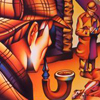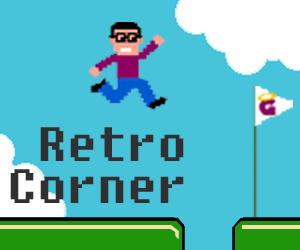 Game: The Lost Files of Sherlock Holmes: The Case of the Serrated Scalpel (1992)
Game: The Lost Files of Sherlock Holmes: The Case of the Serrated Scalpel (1992)
Developer: Mythos Software
Publisher: Electronic Arts
Originally Released on: PC
Currently Available on: Second-hand only: eBay, etc.
The Testament of Sherlock Holmes will be released by Frogwares Interactive later this month, and this will be the latest in a long line of mystery adventure games that have been made, based around the Sherlock Holmes detective stories by Sir Arthur Conan-Doyle. However, back in the early nineteen-nineties, Electronic Arts commissioned Mythos Software to create a new series of games, The Lost Files of Sherlock Holmes, that would be ongoing, and feature original adventures that both new and old fans of the series could play through and be enthralled by.
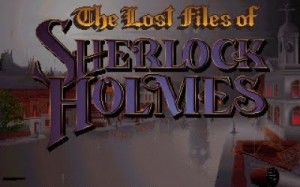 Their first foray into the “Lost Files” of Mr Holmes was in 1992, with “The case of the Serrated Scalpel”, we, the players, found ourselves in the shoes of this most famous of detectives, on the trail of a serial killer whose M.O. carried more than a passing resemblance to that of “Jack the Ripper”. This game puts forward the enduring notion of pitting the fictional brains of Holmes and Watson, against the real-life evil of Jack the Ripper.
Their first foray into the “Lost Files” of Mr Holmes was in 1992, with “The case of the Serrated Scalpel”, we, the players, found ourselves in the shoes of this most famous of detectives, on the trail of a serial killer whose M.O. carried more than a passing resemblance to that of “Jack the Ripper”. This game puts forward the enduring notion of pitting the fictional brains of Holmes and Watson, against the real-life evil of Jack the Ripper.
The setup is our standard one, starting in the apartment at 221B Baker Street, we receive word from the trusty Inspector Lestrade, that the murder of a young actress has been committed. Scotland Yard believe it to be the work of Jack the Ripper, but Holmes detects some inconsistencies and therefore has his doubts. Lestrade wants to close the case as cut and dry, so it is down to the players, as Sherlock, to piece together the truth from the deception. From this point on we are taken on a veritable tour of Victorian London; an elegant West End Theatre, London Zoo, a traditional English Pub and, of course, the Morgue. The further we examine the evidence, the more the intrigue deepens as past loves, family connections and shady characters weave themselves into a complex web of clues.
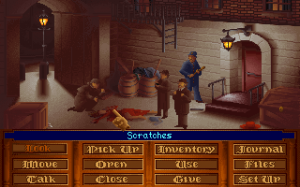 Technically, the game didn’t break down any barriers, but it is nicely presented and evokes the setting well. The graphics are VGA, full 256 colour, and, again, are reminiscent of many games released during that period. Whilst they certainly aren’t up to the standard of later 2D hand-drawn games such as Broken Sword, they sit somewhere around ‘Monkey Island 2’ and ‘Beneath a Steel Sky’, which is certainly good for the time of release. Locations are stylised, but reflect the time period both in terms of architecture and atmosphere and contain some lovely detailing. Character sprites aren’t tremendously detailed, Holmes and Watson obviously receiving the most care and attention, whereas some of the supporting cast can appear somewhat bland and featureless.
Technically, the game didn’t break down any barriers, but it is nicely presented and evokes the setting well. The graphics are VGA, full 256 colour, and, again, are reminiscent of many games released during that period. Whilst they certainly aren’t up to the standard of later 2D hand-drawn games such as Broken Sword, they sit somewhere around ‘Monkey Island 2’ and ‘Beneath a Steel Sky’, which is certainly good for the time of release. Locations are stylised, but reflect the time period both in terms of architecture and atmosphere and contain some lovely detailing. Character sprites aren’t tremendously detailed, Holmes and Watson obviously receiving the most care and attention, whereas some of the supporting cast can appear somewhat bland and featureless.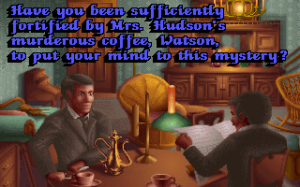
Background music is present in most locations and voices are used occasionally, mostly during the introduction cutscenes and some pre-rendered sections of gameplay. Similarly, the music is suitable but it can become grating and repetitive when staying in one location for an extended period of time. The voices are good when present, for example, Watson and Holmes seem authentic, and the script writing is fine. I do wish that another CD-Rom version had been released with a full speech track, as it certainly adds to the turn of the century ambiance. Digitised sound effects are used sparingly, but are sufficient, without becoming annoying.
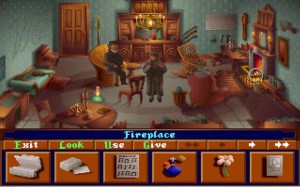 Your investigations will throw up a good amount of red herrings and dead-ends, which serve to add depth to the game. Many characters you will meet seem to have motive or opportunity but, of course, eliminating these possibilities and determining who is really behind the crimes is the point of the game. This depth of suspects does give the game a non-linear feel. You can explore several leads at once and, using the map system for navigation, moving from one location to the next before tying up each new loose end. New locations will be added to the map through speaking to certain characters or discovering the origin of a particular item, and this feels very organic; letting one clue lead to a new scene.
Your investigations will throw up a good amount of red herrings and dead-ends, which serve to add depth to the game. Many characters you will meet seem to have motive or opportunity but, of course, eliminating these possibilities and determining who is really behind the crimes is the point of the game. This depth of suspects does give the game a non-linear feel. You can explore several leads at once and, using the map system for navigation, moving from one location to the next before tying up each new loose end. New locations will be added to the map through speaking to certain characters or discovering the origin of a particular item, and this feels very organic; letting one clue lead to a new scene.
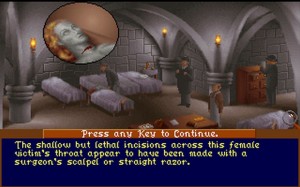 To aid with this myriad of clues, Watson keeps a journal which, if required, the player can access at almost any point. This is very useful for the times when you get stuck and perhaps lose track of where you should be going next. You can also ask Watson for hints and ideas, although, if you were hoping for an in-built hint system you may be disappointed; this is something Watson is not. This option is not likely to be needed very often though.
To aid with this myriad of clues, Watson keeps a journal which, if required, the player can access at almost any point. This is very useful for the times when you get stuck and perhaps lose track of where you should be going next. You can also ask Watson for hints and ideas, although, if you were hoping for an in-built hint system you may be disappointed; this is something Watson is not. This option is not likely to be needed very often though.
This leads to the main criticism aimed at the game, which is that it is perhaps too easy to complete. Luckily, pixel-hunting only really enters the game on a handful of occasions at most, and the majority of answers to puzzles will present themselves to you in the process of speaking to witnesses and the like. Trial and error doesn’t really come into the equation, which, whilst great for amateur adventurers, can seem too simple for others. Back-tracking could also be seen as a problem. Some puzzles can become slightly tedious where you must travel back and forth on what amounts to a “fetch-quest”. This is a minor complaint however, as the puzzles are all logic-based and don’t require the wacky brand of lateral thinking employed by other adventure games such as Sam and Max: Hit the Road.
It is perhaps a shame that after this more than competent release, it took Electronic Arts four years to produce the second “Lost File”, and by this time, the fad for FMV was rampant and the “The Case of the Rose Tattoo” bore little resemblance to this first case. In much the same way as the Gabriel Knight series did, this series spanned the crossover between adventure styles. Both are definitely good games in their own right, but play very differently to one another. Many people nowadays are still put-off by early FMV acting as well, which doesn’t aid the transition. Running the game on modern day computers isn’t a tall task, with dosbox or similar programs easily getting it going. However, I did have some trouble in the setup, where getting the voices to work as they should was time-consuming. I also experienced some crashing out, so be advised to save often; however, in old adventure games, players had to live by that rule regardless.
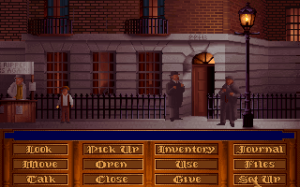 This was a great start to what looked like a promising series of games, unfortunately cut short after only two instalments. The game does, however, still offer a great detective experience, and a fantastic setting. It isn’t a hard game but your investigations will make the game last a good few hours. As it is an Electronic Arts game, a Steam or GOG release is out of the question, and with the licensing issues involved, would EA still be allowed to profit off of a Sherlock Holmes game? If it is possible, this would be a welcome addition to the EA store, as a downloadable release with full compatibility for current operating systems.
This was a great start to what looked like a promising series of games, unfortunately cut short after only two instalments. The game does, however, still offer a great detective experience, and a fantastic setting. It isn’t a hard game but your investigations will make the game last a good few hours. As it is an Electronic Arts game, a Steam or GOG release is out of the question, and with the licensing issues involved, would EA still be allowed to profit off of a Sherlock Holmes game? If it is possible, this would be a welcome addition to the EA store, as a downloadable release with full compatibility for current operating systems.

